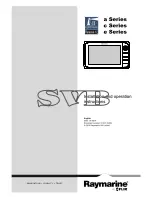
4. Turn the master unit dipswitchws to the “Off” position.
5. Please follow chart on page 13 for all slave dipswitch settings.
Note only one fixture may use the master units dipswitch set-
tings (see Page 13).
6. After all the units settings have been set and are plugged in,
adjust the sensitivity knob on the bottom of the master unit to
make them react to sound.
7. To run a synchronized light show set all the dipswitch on all the
fixture to the ‘off’ position. All fixtures will now run in the same
exact pattern.
8. You can also use the optional MINI/C Remote Control. If you want
to use the optional remote control, connect the MINI/C controller
to the first fixture in the line (master).
Note: The remote control only operates in Stand-Alone and Master/
Slave modes. If the remote is connected in DMX mode it will not func-
tion. If the units do not receive an active DMX signal, the units will
automatically react to sound in the Master/Slave mode.
DMX Mode:
This fixture will react with DMX operation. For best results use only
one motor function for each scene (or step), when programming
scenes into a DMX controller. This will give you faster mirror and fast-
er gobo/color changes. For Example:
A. With the DMX controller move the mirror up then program the
step.
B. Move the mirror down then program that step.
C. Change the gobo/color wheel then program that step.
D. Continue this pattern to achieve best results.
1. Operating through a DMX controller gives the user freedom to
create his/her own programs tailored to their own individual
needs. This function also allows you to use your fixtures as spots.
2. This operation will allow you to control each individual fixtures
traits with a standard DMX 512 controller such as the
American DJ Show Designer™ or the American DJ
®
DMX
Operator.™
3. The DJ Scan 250™ uses four DMX channels to operate; Channel1
is Pan, channel 2 is Tilt, channel 3 is Color, and channel 4 Gobos.
4. To run your fixture in DMX mode, plug in the fixture via the XLR
DJ Scan 250™
Operating Instructions
DJ Scan 250™
Operating Instructions
©
American DJ Supply
®
- www.americandj.com - DJ Scan 250™ Instruction Manual Page 8
©
American DJ Supply
®
- www.americandj.com - DJ Scan 250™ Instruction Manual Page 7
Operating Modes:
You can use the DJ Scan 250
™
in three ways:
• Stand alone mode -
The unit will react to sound, chasing through
the several built in programs. You can also use the optional DJ Scan
MINI/C Remote Control to blackout the units.
• Master/Slave mode -
You can daisy chain up to 4 units together
toget a synchronized light show that will react to sound chasing
through several built in programs.
• DMX control mode -
This function will allow you to control each
individual fixtures traits with a standard DMX 512 controller such as
the American DJ Show Designer.
™
For best results use fog or special effects smoke to enhance the
beams projections. The DJ Scan 250™ comes with a protective
transportation cover. Be sure to remove it before attempting any
operation!
Stand Alone Mode:
1. To operate as a stand alone unit, via its internal chases and
microphone, turn all dipswitches off.
2. Adjust the sensitivity knob on the bottom of the unit so the unit
will react to sound.
3. The DJ Scan 250™ will now react to the bass sound of music via
the internal microphone.
Master-Slave Operation:
This function will allow you to link up to 16 units together to run on
the master unit’s 2 channel internal programs. In Master-Slave opera-
tion one unit will act as the controlling unit and the others will react to
the controlling units programs. Any unit can act as a Master or as a
Slave.
1. Daisy chain your units via the XLR connector on the bottom
of the units.
2. Use standard XLR microphone cables to link your units together.
Remember that the Male XLR connector is the input and the
Female XLR connector is the output.
3. The first unit in the chain (master) will use the female XLR connec-
tor only - The last unit in the chain will use the male XLR connec
tor only.



























